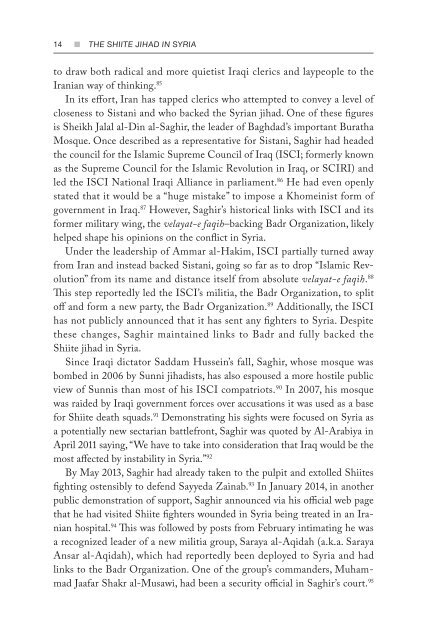You also want an ePaper? Increase the reach of your titles
YUMPU automatically turns print PDFs into web optimized ePapers that Google loves.
14 n <strong>THE</strong> <strong>SHIITE</strong> <strong>JIHAD</strong> <strong>IN</strong> <strong>SYRIA</strong><br />
to draw both radical and more quietist Iraqi clerics and laypeople to the<br />
Iranian way of thinking. 85<br />
In its effort, Iran has tapped clerics who attempted to convey a level of<br />
closeness to Sistani and who backed the Syrian jihad. One of these figures<br />
is Sheikh Jalal al-Din al-Saghir, the leader of Baghdad’s important Buratha<br />
Mosque. Once described as a representative for Sistani, Saghir had headed<br />
the council for the Islamic Supreme Council of Iraq (ISCI; formerly known<br />
as the Supreme Council for the Islamic Revolution in Iraq, or SCIRI) and<br />
led the ISCI National Iraqi Alliance in parliament. 86 He had even openly<br />
stated that it would be a “huge mistake” to impose a Khomeinist form of<br />
government in Iraq. 87 However, Saghir’s historical links with ISCI and its<br />
former military wing, the velayat-e faqih–backing Badr Organization, likely<br />
helped shape his opinions on the conflict in Syria.<br />
Under the leadership of Ammar al-Hakim, ISCI partially turned away<br />
from Iran and instead backed Sistani, going so far as to drop “Islamic Revolution”<br />
from its name and distance itself from absolute velayat-e faqih. 88<br />
This step reportedly led the ISCI’s militia, the Badr Organization, to split<br />
off and form a new party, the Badr Organization. 89 Additionally, the ISCI<br />
has not publicly announced that it has sent any fighters to Syria. Despite<br />
these changes, Saghir maintained links to Badr and fully backed the<br />
Shiite jihad in Syria.<br />
Since Iraqi dictator Saddam Hussein’s fall, Saghir, whose mosque was<br />
bombed in 2006 by Sunni jihadists, has also espoused a more hostile public<br />
view of Sunnis than most of his ISCI compatriots. 90 In 2007, his mosque<br />
was raided by Iraqi government forces over accusations it was used as a base<br />
for Shiite death squads. 91 Demonstrating his sights were focused on Syria as<br />
a potentially new sectarian battlefront, Saghir was quoted by Al-Arabiya in<br />
April 2011 saying, “We have to take into consideration that Iraq would be the<br />
most affected by instability in Syria.” 92<br />
By May 2013, Saghir had already taken to the pulpit and extolled Shiites<br />
fighting ostensibly to defend Sayyeda Zainab. 93 In January 2014, in another<br />
public demonstration of support, Saghir announced via his official web page<br />
that he had visited Shiite fighters wounded in Syria being treated in an Iranian<br />
hospital. 94 This was followed by posts from February intimating he was<br />
a recognized leader of a new militia group, Saraya al-Aqidah (a.k.a. Saraya<br />
Ansar al-Aqidah), which had reportedly been deployed to Syria and had<br />
links to the Badr Organization. One of the group’s commanders, Muhammad<br />
Jaafar Shakr al-Musawi, had been a security official in Saghir’s court. 95


